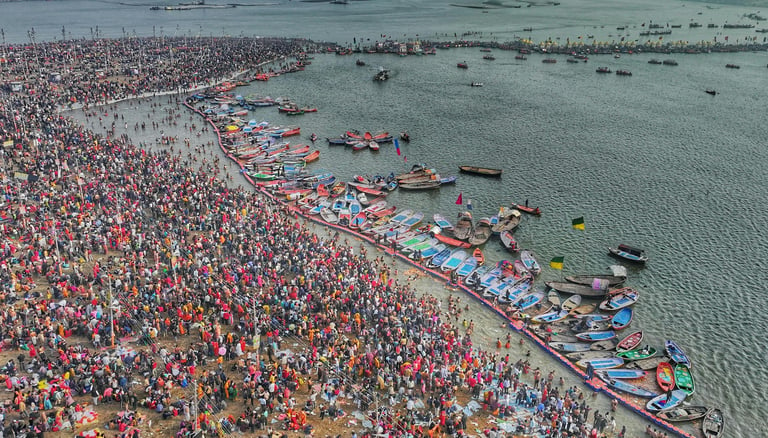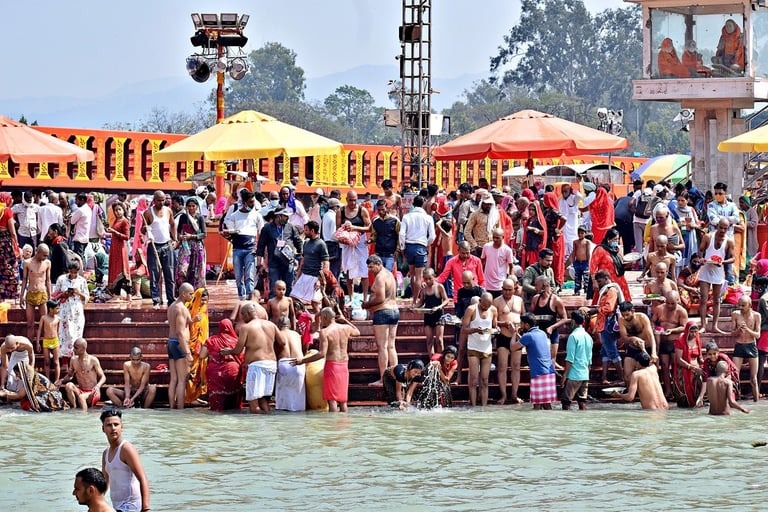Kumba Mela: The Evolution of Faith and Culture Through the Ages
Experience the timeless journey of the Kumba Mela, where ancient rituals evolve into a modern celebration of unity and spirituality. Uncover how this grand gathering has both shaped and been shaped by centuries of cultural evolution and unwavering faith.
CULTUROSCOPE


The Kumbh Mela, one of the largest spiritual gatherings in the world, stands as a profound confluence of mythology, history, and cultural vibrancy. Held cyclically at four sacred riverbanks—Prayagraj (Allahabad), Haridwar, Nashik, and Ujjain—the festival is a living testament to India’s deep-rooted spiritual traditions. Over the centuries, Kumbh Mela has evolved into a unique phenomenon, weaving together the spiritual aspirations of millions with the mysticism of its mythological origins and historical significance.
This article delves into the fascinating history of the Kumbh Mela, exploring its evolution from ancient mythological tales to a globally recognized spiritual event. Through the lens of historical records, mythological epics, and modern interpretations, we uncover the enduring significance of this unparalleled celebration.
Mythological Foundations: The Tale of Amrita
The origins of Kumbh Mela are enshrined in the sacred tale of the Samudra Manthan (churning of the ocean of milk), an episode from Hindu mythology. In this cosmic event, the devas (gods) and asuras (demons) joined forces to churn the ocean in pursuit of amrita—the nectar of immortality. The struggle for this divine elixir turned chaotic when a fierce battle erupted. To prevent the nectar from falling into the hands of the asuras, Lord Vishnu assumed the form of Mohini, an enchanting maiden, and skilfully distributed the nectar to the devas.
As the battle ensued, drops of the amrita spilled at four earthly locations: Prayagraj, Haridwar, Nashik, and Ujjain. These sites were consecrated by this divine nectar and are believed to possess unparalleled spiritual energy. The Kumbh Mela celebrates this celestial event, with millions gathering to bathe in the rivers, seeking purification of the soul and liberation from the cycle of birth and rebirth (moksha).
Ancient Texts and Literary Echoes
The sanctity of the Kumbh Mela is echoed in ancient Indian scriptures and epics. The Mahabharata narrates the Pandavas’ pilgrimages to sacred rivers, emphasizing the transformative power of bathing at river confluences. Similarly, the Ramayana highlights the importance of ritualistic bathing, drawing parallels to the practices observed during the Kumbh Mela.
Medieval texts like the Puranas provide more explicit references to the Kumbh Mela, detailing the astrological alignments that govern its occurrences. According to these texts, the positioning of Jupiter, the Sun, and the Moon determines the timing of the festival at each site, reflecting the profound interplay of cosmic forces in Hindu cosmology.
The devotional fervour surrounding river pilgrimages is further immortalized in the works of poet-saints like Tulsidas, whose Ramcharitmanas captures the collective devotion of pilgrims. Though Tulsidas does not directly reference Kumbh Mela, his writings resonate with the spiritual essence of such gatherings, emphasizing the transcendental experience of connecting with the divine through faith and devotion.
While mythology forms the soul of the Kumbh Mela, its historical trajectory reveals its evolution into a grand socio-cultural event. One of the earliest mentions of river-based rituals comes from Megasthenes, a Greek historian who visited India during the reign of Chandragupta Maurya (circa 300 BCE). Megasthenes noted the practice of ritual bathing as a means of spiritual purification, a precursor to the organized gatherings we see today.
The 7th-century Chinese traveller Xuanzang documented large-scale religious assemblies at riverbanks during his visit to King Harsha’s court. Although he did not explicitly mention the Kumbh Mela, his descriptions reflect traditions similar to those celebrated at the festival.
By the Gupta period (4th–6th centuries CE), the formalization of river pilgrimages began to take shape, with inscriptions pointing to large congregations for spiritual rites. The medieval scholar Al-Biruni, in the 11th century, also remarked on the vast gatherings of Hindus for ritualistic purposes, underscoring the enduring significance of such events.
During the Mughal era, religious diversity thrived alongside political and cultural shifts, and the Kumbh Mela continued to grow in prominence. Although Mughal texts do not explicitly mention the festival, they provide valuable context. For example, the Ain-i-Akbari, written by Abul Fazl during Emperor Akbar’s reign, highlights the importance of large religious gatherings in Indian culture. Akbar’s respect for spiritual diversity and his establishment of Allahabad (now Prayagraj) as a prominent cultural hub likely contributed to the festival's continuity.
In the colonial era, renewed interest in Indian traditions led to detailed documentation of the Kumbh Mela. Sir William Muir, a British administrator and historian, played a notable role in recording its scale and significance. As the Lieutenant Governor of the North-Western Provinces, he marvelled at the festival’s sheer size and described its meticulous organization, noting the millions of pilgrims who attended for spiritual purification.
The 1954 Kumbh Mela in Allahabad was a watershed moment in the festival's history. It marked the first major gathering after India’s independence, symbolizing not just a spiritual resurgence but also a collective assertion of cultural identity. The newly independent nation embraced the festival as a celebration of its heritage, with increased efforts to formalize and organize the event.
Unfortunately, the 1954 Mela was also marred by tragedy. That year, an unprecedented five stampedes occurred, resulting in the tragic loss of over 800 lives, with thousands injured. The worst of these incidents unfolded on February 3, 1954, as an overwhelming surge of pilgrims converged on the bathing ghats. The narrow pathways, combined with inadequate crowd control measures, proved disastrous. The tragedy highlighted the complexities of managing human and environmental interplay in such colossal gatherings.
The stampedes served as a sombre reminder of the festival’s risks, prompting significant reforms. Modern crowd management techniques, including barricades, designated zones, and emergency response systems, owe much to the lessons learned from the 1954 Mela.
Today, the Kumbh Mela continues to thrive, attracting millions from around the world. Advances in technology and governance have ensured the seamless execution of the festival, while its spiritual core remains unchanged.
Rituals and Cultural Significance
The Kumbh Mela is a profound reflection of India’s spiritual and cultural heritage, where ancient rituals blend seamlessly with contemporary life. At its core is the shahi snan (royal bath), led by naga sadhus and other ascetics, who embody renunciation and spiritual discipline. Adorned in saffron robes and smeared with ash, these ascetics lead grand processions to the sacred rivers, captivating pilgrims with their devotion.
The ritual of bathing in the rivers is believed to cleanse sins and bring spiritual liberation. Alongside, devotional kirtans, spiritual debates, and discourses create an atmosphere of introspection and enlightenment.
Beyond religion, the Kumbh Mela celebrates India’s cultural diversity. It is a platform for spiritual exchange, artistic expression, and collective reflection, drawing millions across caste, creed, and nationality. Through its timeless rituals, the festival symbolizes unity in diversity and the deep bond between humanity and the divine.
Environmental Interplay
The Kumbh Mela’s relationship with its natural surroundings is profound. The festival underscores the spiritual and ecological significance of water. Pilgrims regard the rivers not merely as waterways but as living deities that cleanse sins and restore harmony.
However, the environmental pressures of the festival cannot be overlooked. The influx of millions of pilgrims impacts the fragile river ecosystems, leading to challenges such as water pollution, excessive waste generation, and strain on local resources. Despite this, efforts to mitigate these impacts are gaining momentum. The introduction of eco-friendly practices, waste management systems, and awareness campaigns reflects an evolving recognition of the need to balance faith with environmental stewardship.
The Kumbh Mela is more than a festival—it is a living legacy that bridges the realms of mythology, history, and the environment. From its mythological inception in the tale of the Samudra Manthan to its modern-day grandeur, the Kumbh Mela is a living testament to the richness of India’s spiritual and cultural heritage. Amid the challenges of scale and environmental pressures, the Mela continues to inspire awe, reminding us of the timeless power of devotion and the delicate balance we must maintain with the natural world.
Subhalakshmi Buragohain
Hyderabad
Kumbh Mela: The Grand Confluence of Humanity and Faith


A journey of purification and spiritual renewal.
